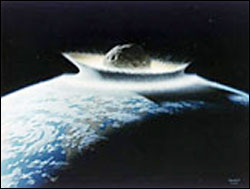Martian meteorite measurements give information on planet evolution

Artist’s rendering of meteorite impact on Earth. NASA
Scientists in the department of Geology and Geophysics at Yale University have devised a method to precisely date the timing and temperature of a meteorite impact on Mars that led to ejection of a piece of the planet into space and its eventual impact on Earth.
Meteorites are the main source of mass exchange between planets and carry with them characteristic clues about the nature and history of the planets or planetesimals where they originated, the impacts that dislodged them, and the time they spent in space.
Kyoungwon Kyle Min, postdoctoral fellow in geology, reported an innovation for determining the timing and temperatures of ancient impacts that liberate meteorites from extraterrestrial bodies such as Mars.
To measure both the age and thermal history of the piece of Martian rock, Min assayed the natural radioactive decay of uranium and thorium to the gas helium in these meteorites, and combined it with knowledge of how temperature affects helium loss over time. This (U-Th)/He dating method, used on single grains of minerals in the “Los Angeles” Martian meteorite gave a far more accurate picture than the conventional method of analyzing chunks of meteorite. The “helium age” of about three million years corresponds with the estimated cosmogenic space exposure age.
According to co-author Assistant Professor Peter W. Reiners, “The three million-year age of this meteorite is also important because other meteorites we’re working on, including some Martian ones, are several hundred million to billions of years older. These methods allow us to better understand both the timing and dynamics of ancient impacts on other planets, and how these events relate to interplanetary material transfer.”
Scientists have long looked at meteorites to answer the question of whether there is now, or once was, life on Mars. They now can compare data from meteorites with the observations of space vehicles to learn more about past activities on the surface of Mars.
Media Contact
More Information:
http://www.yale.eduAll latest news from the category: Earth Sciences
Earth Sciences (also referred to as Geosciences), which deals with basic issues surrounding our planet, plays a vital role in the area of energy and raw materials supply.
Earth Sciences comprises subjects such as geology, geography, geological informatics, paleontology, mineralogy, petrography, crystallography, geophysics, geodesy, glaciology, cartography, photogrammetry, meteorology and seismology, early-warning systems, earthquake research and polar research.
Newest articles

Webb captures top of iconic horsehead nebula in unprecedented detail
NASA’s James Webb Space Telescope has captured the sharpest infrared images to date of a zoomed-in portion of one of the most distinctive objects in our skies, the Horsehead Nebula….

Cost-effective, high-capacity, and cyclable lithium-ion battery cathodes
Charge-recharge cycling of lithium-superrich iron oxide, a cost-effective and high-capacity cathode for new-generation lithium-ion batteries, can be greatly improved by doping with readily available mineral elements. The energy capacity and…

Novel genetic plant regeneration approach
…without the application of phytohormones. Researchers develop a novel plant regeneration approach by modulating the expression of genes that control plant cell differentiation. For ages now, plants have been the…





















